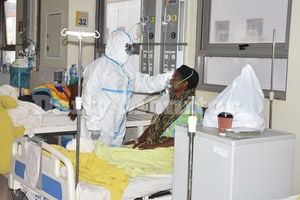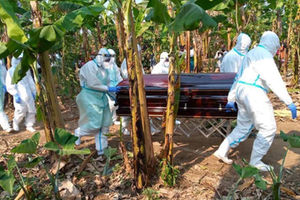
Health Minister Dr Jane Ruth Aceng (left) looks on as a nurse administers an Ebola vaccine to a UPDF soldier during the launch of the exercise for soldiers at Muhooti Barracks in Fort Portal on August 30, 2022. PHOTO/FILE
Between 2012 and 2022 in Uganda, there were more than 5,000 suspected and confirmed cases of yellow fever. The Health ministry said in the first phase of the vaccination in six regions—specifically focused on 51 districts—including Arua, Gulu, Hoima, Kabale, Kabarole and Lira, many people were vaccinated within a week because there was minimal resistance.
However, following the launch of the second phase of the campaign in Kampala, Wakiso and other 51 districts on April 2, the ministry reported facing a lot of resistance to vaccination.
What sort of figures are we talking about here?
As a result of the resistance, the percentage of people vaccinated within a week was also below the numbers in the first phase.
“By midday today [April 8], we got (vaccinated) 53 percent of the targeted 14 million people. This is below 60 percent and it is below phase one,” Dr Henry Mwebesa, the director general of Health Services at the ministry, said, noting that the mass vaccination was supposed to run from April 2 to April 8.
“We are not doing well as we did in phase one where we had 71 percent. That is why we have extended the vaccination for another one week (until April 14),” Dr Mwebesa added.
The sub-optimal uptake raises two questions. Firstly, whether the ministry is introducing the vaccine against a disease that people believe is a big threat to them. Secondly, whether the general mistrust of government services among some people is contributing to the vaccine hesitancy.
“When you are threatened that the disease is dangerous, you are going to do something about it,” Dr Simon Peter Sebina Kibira, a lecturer in the Department of Community Health and Behavioural Sciences at the Makerere University School of Public Health, observed.
Are people right to question the mass vaccination campaign on account of the absence of a disease outbreak and the free tag it comes with?
The Health ministry says the mass vaccination drive is part of the global target of eliminating the disease, which it said is endemic in the country.
“The yellow fever vaccination campaign is an opportunity for the Ministry of Health to bridge the gap of communities that have never been vaccinated against yellow fever, free of charge,” Dr Diana Atwine, the ministry’s Permanent Secretary, said.
According to information from the World Health Organization (WHO), in Africa, “27 countries, including Uganda, have been classified as high-risk for yellow fever.” WHO adds that Uganda “has a history of outbreaks reported in 2020 (Buliisa, Maracha and Moyo districts), 2019 (Masaka and Koboko districts), 2016 (Masaka, Rukungiri, and Kalangala districts) and in 2010 when 10 districts were affected in northern Uganda.”
Information from the global health agency also shows that in 2022, out of the total of seven suspected cases of yellow fever, there was “one laboratory-confirmed case of yellow fever reported from Wakiso District, central region.”
According to a 2023 report by the Uganda National Institute of Public Health (UNIPH), the outbreak of yellow fever has been frequent in the past six years. The researchers found that between “January 2012 and July 2022, a total of 5,5437 suspected and 24 confirmed yellow fever cases were reported.”
UNIPH, in their policy brief earlier in 2020, observed that the first documented outbreak of yellow fever in Uganda was reported in Bwamba County, western Uganda in 1941, with subsequent outbreaks in 1952, 1959, 1964, 1971 and 2010.
According to the institute, the largest yellow fever outbreak in Uganda occurred in “northern Uganda in 2010 and affected 181 people, of which 45 died.”
What exactly is yellow fever?
Yellow fever is a viral infection that is spread to humans through a bite of a mosquito infected with the fellow fever virus. It causes fever, yellowing of the eyes and bleeding from any openings such as the mouth, nose, eyes, and ears.
“Yellow fever falls in the same group [as] Ebola. Those are dangerous diseases spread by mosquitoes; one case constitutes an outbreak,” Dr Ombeva Malande, a vaccinologist at the Uganda’s Health ministry, said, adding, “There are rising cases in neighbouring countries, and Uganda is at serious risk. So serious is yellow fever that it’s the only disease that has a mandatory international requirement for vaccination if one is to travel to another country. It carries great public health concern.”
In 2017, a comprehensive global strategy to eliminate yellow fever epidemics was developed by WHO and a coalition of partners (Gavi and Unicef) roped in to eliminate yellow fever epidemics by 2026. In the strategy, the interventions include the mass vaccination and the introduction of “the yellow fever vaccine into the national routine immunisation schedule”, which the Health ministry also said it did in October 2022 for children nine months old.
There is still no approved drug for treatment of the viral disease, according to the WHO. Vaccination, therefore, is the recommended strategy for prevention. The WHO also notes that “most” people who get infected with the disease recover within three or four days but some progress to severe symptoms.
Is the govt taking the fight to anti-vaxxers?
The low turnout at vaccination points in the Kampala metropolitan area, also raises the questions about effectiveness of the strategies the ministry is employing to improve vaccine uptake, majorly in areas that have continually reported low uptake.
The metropolitan area, specifically Wakiso, has been performing poorly even in other essential vaccines for children, according to a recent report by Gavi Zero Dose Learning Hub in Uganda. According to their report, in Uganda, Wakiso has the highest number of children who have not received essential vaccines (25,964 zero-dose children), followed by Mubende (3,389) and Kasese (943).
According to the report, vaccine hesitancy is being driven by fear of side effects of vaccines, and the rise in persuasive anti-vaxxers—especially informed elites who are opposed to vaccination. The researchers also cited mistrust, limited sensitisation, religious and cultural beliefs against vaccination, and also challenges in vaccine delivery, distance to facilities and vaccine stockouts as hindrances.
“We have the anti-vaxxers coming up. Those are very learned people, they are elites. They review vaccines, do their study and come up with their evidence to fight, so with new vaccines coming in, we have more and more hesitancy challenges. So we need to think through and prepare as we introduce the vaccines,” Ms Jackline Anena, the technical advisor for vaccines and immunisation at PATH, a global health organisation, observed.
Dr Daniel Kyabayinze, the head of public health at Uganda’s Health ministry, said police “should take interest” in people who are running social media campaigns against vaccination, saying “they can potentially cause loss of life.”


